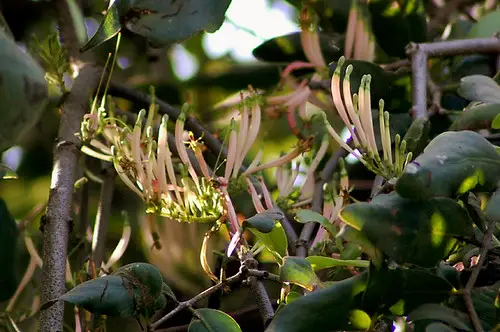Mistletoe Cactus, scientifically known as Rhipsalis, is a unique cactus that stands out from its desert-dwelling cousins. Unlike the traditional cactus, it’s a tropical plant that thrives in rainforests. Originating from Central and South America, the Caribbean, and Florida, Mistletoe Cactus is a fascinating species with over 35 different varieties. It has a cascading growth pattern and offers a delicate appearance with its thin, hair-like stems.
The Mistletoe Cactus is often referred to as an “epiphytic” cactus, meaning it naturally grows on other plants or trees in the wild. Despite its fragile appearance, the Mistletoe Cactus is a hardy and adaptable houseplant that brings a touch of the tropics into the home.
What sets the Mistletoe Cactus apart from other cacti is its care requirements, which are closer to tropical plants than desert ones. It offers an easy and rewarding growing experience, providing lush greenery and even delicate white flowers when well cared for.
| Attribute | Details |
|---|---|
| Common Names | Mistletoe Cactus, Coral Cactus |
| Botanical Name | Rhipsalis |
| Family | Cactaceae |
| Plant Type | Epiphytic Cactus |
| Mature Size | Up to 10 feet in length (cascading) |
| Sun Exposure | Partial shade to filtered sunlight |
| Soil Type | Well-draining, peat-based potting mix |
| Hardiness Zones | 10-12 |
| Native Area | Central and South America, Caribbean, Florida |
Mistletoe Cactus Care
The Mistletoe Cactus care involves understanding its tropical nature and providing the right amount of water, light, and humidity. Unlike desert cacti, it prefers consistent moisture and humidity. However, good drainage is essential to prevent root rot.
Positioning the Mistletoe Cactus in a location with bright but filtered sunlight and watering it when the soil feels dry to the touch ensures healthy growth. Regular feeding during the growing season supports robust development, and an annual repotting keeps the plant thriving.
Light Requirement for Mistletoe Cactus
Mistletoe Cactus prefers partial shade to filtered sunlight. Too much direct sunlight can cause the thin stems to become scorched, while insufficient light might lead to leggy growth. An east or north-facing window is typically suitable for this plant.
Soil Requirements for Mistletoe Cactus
A well-draining peat-based potting mix is ideal for Mistletoe Cactus. Mixing in perlite or sand can further improve drainage. Avoid heavy, clayey soil, as it can lead to water retention and root rot.
Water Requirements for Mistletoe Cactus
Unlike desert cacti, Mistletoe Cactus requires consistent moisture. Water the plant when the top inch of soil feels dry, but make sure not to overwater. It’s vital to allow the soil to dry slightly between waterings to prevent waterlogged conditions.
Temperature and Humidity
Mistletoe Cactus enjoys a warm and humid environment. It thrives in temperatures between 60-80°F (16-27°C). Maintaining higher humidity levels, either by misting or using a humidifier, is beneficial for this tropical cactus.
Fertilizer
Feed Mistletoe Cactus with a balanced liquid fertilizer diluted to half-strength during the growing season, roughly once a month. Avoid over-fertilizing, as it may lead to excessive growth without the accompanying support structure.
Pruning Mistletoe Cactus
Pruning is rarely necessary for Mistletoe Cactus. However, if desired, you can trim back any unattractive or overgrown stems to maintain the shape and size of the plant.
Propagating Mistletoe Cactus
Propagation of Mistletoe Cactus is done by taking stem cuttings. Simply cut a healthy stem, let it dry for a day, and then plant it in a well-draining soil mix.
How To Grow Mistletoe Cactus From Seed
Growing Mistletoe Cactus from seed is a more time-consuming process but possible. Sow seeds in a well-draining mix, keep them warm, and maintain a humid environment for successful germination.
Common Pests & Plant Diseases
Mealybugs
These can be removed with a cotton swab dipped in alcohol.
Fungal Diseases
Caused by overwatering; ensure proper drainage and watering practices.
Common Problems With Mistletoe Cactus
Shriveled Stems
Often due to underwatering.
Pale Growth
Caused by too much direct sunlight.
Pro Tips
- Use a pot with good drainage to prevent waterlogged soil.
- Provide support if the plant becomes too heavy with growth.
- Avoid placing the plant near heaters or vents, as dry air can harm it.
- Repot every 2-3 years to refresh the soil and inspect the roots.
- Be patient with flowering; it may take a few years for flowers to appear.




